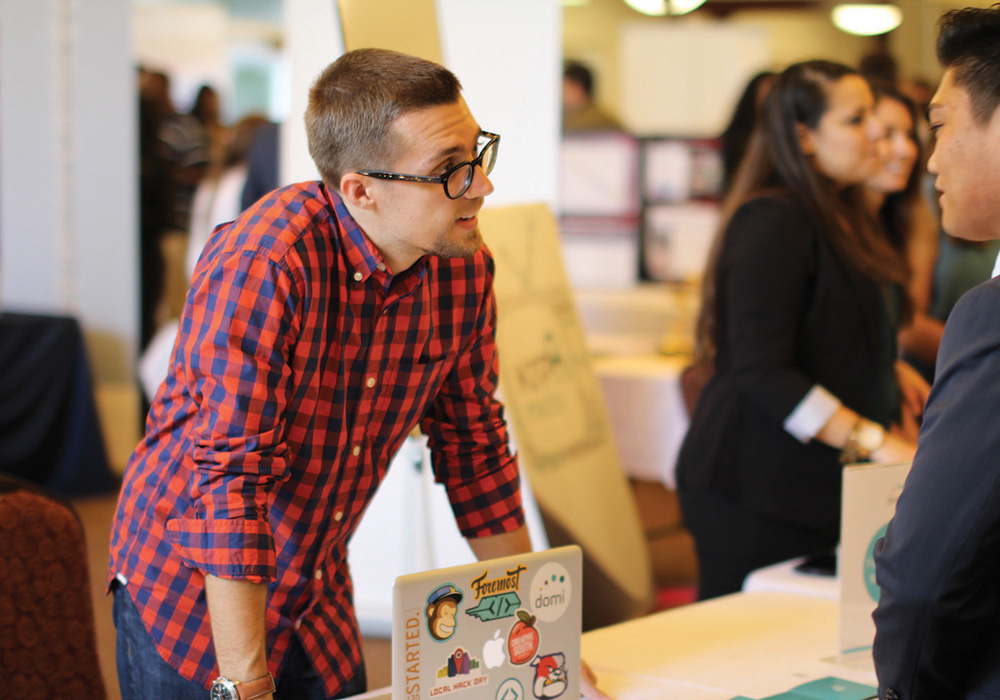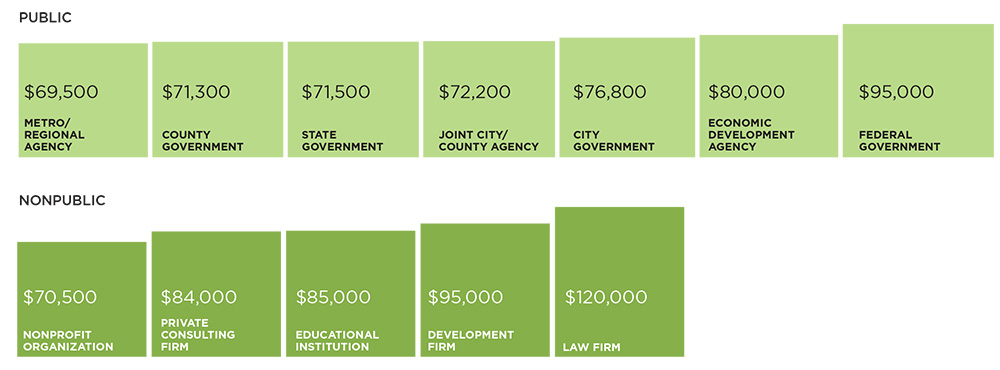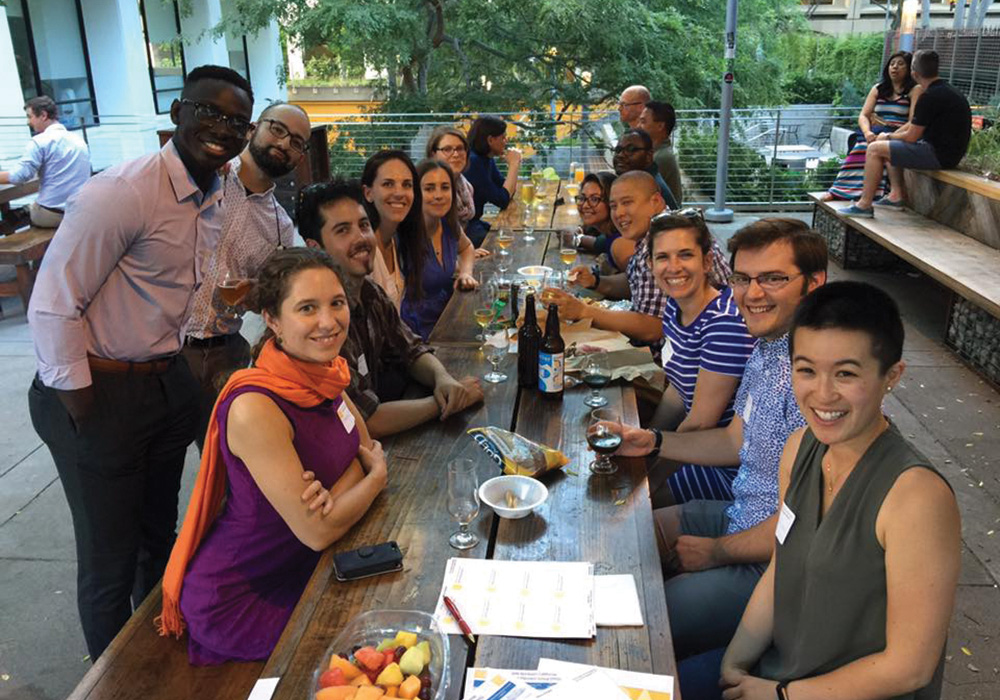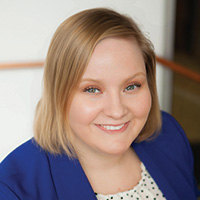Planning July 2017
A New Course
Millennial planners — like their peers in other professions — are taking over the workforce. How do these young professionals value and approach their work?
By Ryan Holeywell
After earning her master's degree in city and regional planning from Rutgers University last year, Ai Yamanaka wanted to do some exploring.
A fellowship with the Port Authority of New York & New Jersey proved to be the perfect career fit. The program will allow her to spend two years rotating through four different departments. The goal is to expose young professionals to different facets of the agency before placing them in a permanent job.
"It sort of gave me the chance to home in on what I wanted to do," says Yamanaka, who's already worked in operations at John F. Kennedy International Airport and is currently in the planning and regional development department.
Yamanaka — like many of her peers — wants to explore her options. But she also knows it can take time for a young employee to find her footing within a major organization. That made the fellowship perfect for her.
"Personally," Yamanaka says, "I would like to stay in an organization long enough to feel like I understand how the agency works."
Yamanaka's desire to have a diversity of experiences is shared by many young planners, who are increasingly open to working in different types of roles — often outside of the planning department, or even the public sector — if they feel the experience will be challenging or rewarding. And the values of Yamanaka's generation — a desire for real responsibility, an interest in innovation, and a commitment to the community — are quickly changing the landscape of the planning workforce.

Lucas Lindsey talks with students at a career fair about internship opportunities with Domi Station, the startup incubator in Tallahassee, Florida, where he is the executive director. Photo Courtesy Florida State University.
Public-private shift
Even as he was pursuing his master's degree in urban planning at Florida State University three years ago, entrepreneur Lucas Lindsey knew he didn't want to work in a traditional government planning job.
Following internships in state and local government, he realized the public sector wasn't a good fit for him, despite his fascination with the concepts he was studying at school.
He liked the idea of working closely with communities, but he didn't think a public-sector job would offer him that opportunity.
In internships and jobs with private-sector commercial and multifamily developers, however, Lindsey felt like he was having a real impact, touching communities and seeing projects he worked on come to life quickly.
Today, he's executive director of Domi Station, a Tallahassee coworking space and startup incubator. He's currently working with partners to develop a food truck market downtown.
And as a neighborhood advocate who is passionate about good planning, he's promoting redevelopment in the city in hopes of revitalizing neighborhoods and improving the city's economy.
It's not a traditional path for someone with undergraduate and graduate degrees in urban planning. But Lindsey's experience is reflective of many young planners today.
"Students are interested in a diverse array of opportunities," said Krystyn Kitto, assistant director of career services and alumni relations at Rutgers University's Edward J. Bloustein School of Planning and Public Policy. "They don't want to just do the work; they want to see how it's impacting people."
Others agree. One word that comes up often is "mission," says Nicole Woods, AICP, who is the lead planner in the Community Development Department of Buffalo Grove, Illinois.
When advising recent grads from her alma mater, Rutgers, they often tell her that believing in an organization's mission is critically important to them.
Planning has always attracted its share of do-gooders, Woods says, but with millennials the need to make a difference — right away — seems stronger. When she landed her first few planning jobs 10 years ago, her main goal was a bit different: gaining skills and getting experience, she says.
Another thing young planners tell Woods is that they only want to work in a city, not the 'burbs. "I get it," says Woods, who's done both. "Especially during the downturn, I'd tell people that it's better to work in the suburbs and get some solid experience for a few years than to live in the city and work at Jamba Juice."
While he isn't passionate about it personally, Lindsay says public-sector planning is vital. "We need it in our communities," he says, "but I do think the definition of planning is expanding, and I think that's exciting."
How Much Do Planners Make?
The answer depends on a few variables, and every other year, APA and AICP conduct the Planners Salary Survey to find out. The difference can come down to experience level, of course, and AICP status. In fact, the typical AICP member takes home about $16,000 more than an equivalent planner without the certification. What really can make a difference, though, is where you are employed. About 70 percent of planners surveyed work for a public entity, but their median salary is about $2,000 less than the field's overall median, $77,000.

Source: American Planning Association
Influencing factors
This career-diversification trend isn't all that new, says Curtis Winkle, an urban planning professor at University of Illinois at Chicago. "For years, our students have been going into areas that may not be traditionally considered 'planning,'" he says. But it may be becoming more pronounced.
New planners are entering areas such as community development, city management, and sustainability. They're working at private startups, think tanks, and incubators. They're pursuing careers with law firms, developers, marketers, engineering firms, logistics companies, and tech firms. And in some cases, they're bouncing back and forth a bit.
"I don't think [young planners] see the sectors as being as separate as they have in the past," says Lois Takahashi, an urban planning professor at UCLA. "They're more fluid, and their networks spread across sectors."
Some of that shift is due to the desires of young planners themselves. In the private sector, they're able to pursue shorter-term projects and see tangible results quickly, as opposed to the public-sector processes, where the perception is that on-the-ground change takes much longer. And with the rise of public-private partnerships, planners can still be involved with the public sector, even if a government agency is not their employer.
Woods acknowledges that things can move slowly in the public sector, but says there's another side to that coin. "You are at the forefront, especially in a municipality, of implementing plans that consultants [might] have prepared for you," she says. "A con of the consulting world is that you go in, do the plan or project, and then leave and never really know if [it was put in place] or is truly making a difference. Implementing plans is exciting, rewarding, and gratifying — I was so excited to actually implement better shared parking! — but it often happens at a glacial pace."
"Our alums don't feel that the only option is to work for a city planning department," says Takahashi, who also serves as president of the Association of Collegiate Schools of Planning. "What's new for (planning students and educators) is this idea that the private sector has these different sorts of opportunities," she adds. "They may be things that can be done there more quickly or in a multidisciplinary sort of way."
The shift may also be happening out of necessity — a result of the realities of employment in the years following the Great Recession. Nationwide, local government budgets at the time were strained in the wake of the recession.
As a result, young planners "were pressured to launch when traditional paths weren't working as usual," says Richard Willson, FAICP, an urban planning professor at Cal Poly Pomona and author of the forthcoming book A Guide for the Idealist: How to Launch and Navigate Your Planning Career.
"It's partly them doing it, and it's partially something that's happened to them," Willson says. "During good times, it would be easy for a young planner to land a job in a municipality. During leaner times, they were forced to explore other ways of using their planning skills."
Indeed, in April 2017 (the most recent data that was available at press time), local governments employed about 14.4 million people, according to Bureau of Labor Statistics data compiled by Governing magazine. But before that — when many of the current crop of young planners were starting out — the public sector was reeling.
There are 400,000 more jobs in local government today than there were four years ago. But from 2009 to 2013, more cities were trying to cut payroll than expand it, according to the National League of Cities.
Today, things are on the upswing. In NLC's latest report, half of the cities said they're increasing spending on their workforce, compared to just seven percent who are still cutting. According to the Bureau of Labor Statistics, as of May 2016, there were about 35,000 urban and regional planners working in the U.S. About 81 percent worked for the government in one form or another, and the agency's 10-year projections don't forecast a major change to that rate.
On the whole, the situation for municipal employees, and planners, appears to have stabilized. Those numbers might undermine the thesis that the career path of today's planners is changing. But they don't fully reflect early career planners' increasing willingness and interest in a moving among the public, private, and nonprofit sectors.
Megan Spitz, for example, works as a senior interagency liaison at the Illinois Housing Development Authority. She's not sure where her career will take her, but she doesn't expect to stay at the agency forever. "I would be interested in working for a local municipality for a few years, or going to a firm, then going back to state or local government," she says. "[I want] to use my skills in different ways and to learn different things. I don't necessarily want to be an expert on one thing and rely on it my whole life. I like learning broadly, about more and more things."
Like Spitz, many young planners interviewed say they want to explore the private sector because of the diversity of work experiences it can offer. They also see it as a place that may be more likely to embrace their enthusiasm and offer them the chance to make tangible impacts on projects early in their careers.
Kendall Wendling, AICP, an urban planner at Halff Associates, started working there after five years at the North Central Texas Council of Governments, the Dallas area's metropolitan planning organization. She says the private sector gave her more varied work experiences. In fact, within her cohort at University of Texas at Arlington, from which she graduated in 2013, only a handful are working in municipal planning departments, she says. Most work in the private sector, like her.
"With any public-sector job, there is going to be a level of bureaucracy or red tape," Wendling says. "Your ideas have to be reined in a bit, maybe because of the political climate, or the decision of a council or mayor. I think newer planners tend to like the freedom to be more creative."
Then again, Sheri Smith, AICP, interim chair of the planning program at Texas Southern University in Houston, says she sees young planners tending toward specialization. That, plus an inclination toward hands-on work, may make the private sector attractive. She says young planners seem to relish the opportunity to work at the intersection of multiple policy areas and collaborate with peers in different professions, such as architects and engineers.
"They don't want to be one of 30 to 45 planners in an agency," Smith says. "They want to be busy and engaged, and they want to see the results of their efforts."
For a Great Career, Start With a Plan
By Bobbie Albrecht
Your career isn't a straight line. According to the Bureau of Labor Statistics, the average worker typically holds 10 different jobs before age 40, and this number is projected to grow among younger workers. It pays to be prepared for your next planning career move by, you guessed it: making a plan.
Start with where you are and think about where you want to be.
CREATE A SWOT ANALYSIS for yourself. Take a long look at your strengths, weaknesses, opportunities and threats, and do an honest self-appraisal. Can you leverage your strengths with your employer? Can you find a place where you can work on filling gaps in your skills? Threats can be obstacles or challenges. A Guide for the Idealist blog series has several posts with advice to help you navigate the choppy waters of politics and office culture.
SCAN YOUR CURRENT LANDSCAPE. What opportunities are available for growth, learning new skills, and gaining experience?
TALK WITH YOUR SUPERVISOR to make a case using your SWOT information — a signal to your supervisor that you are ready to grow your abilities, increase your responsibility, and take on a new challenge.
GET ADVICE from practicing planners. Find someone who will be a sounding board and reality check. National Planning Conferences (and other meetings) are ideal places to find potential mentors. Each year, there are plenty of social opportunities, a job fair, and career track sessions, as well as a Mentor Match program. When you have a clear idea of what you're looking for, a mentor can open doors.
CONNECT WITH PLANNERS with the same interests. APA divisions are communities of passionate professionals organized around practice areas and can help you network and channel an interest into a career opportunity.
If you do these things as you navigate your own career path, you'll get where you want to go — and enjoy the journey.
Bobbie Albrecht is APA's career services manager.
Changing with the times
UCLA's Takahashi says she's also noticing that planning professionals are going into the public sector but working outside the planning department in areas such as information technology, community health, or sustainability. She's also seen more young planners moving into the field of community engagement, working to help governments rethink the way they interact with their communities. Those trends are driven by young planners who see "planning" not necessarily as a career unto itself but as a skill that can help them in other areas.
"I accepted this job because it really focused on innovative approaches to engaging with the community," says Giovania Tiarachristie, a neighborhood planner at the New York City Department of Housing Preservation and Development. Traditionally, she says, some workers may become frustrated by the bureaucracy that may accompany public-sector work. But she found her agency attractive because it focused on neighborhood-level work and allowed for lots of collaboration — with other agencies, with residents, and with other stakeholders.
Ai Yamanaka, the leadership fellow with the Port Authority of New York & New Jersey, says her job was attractive to her because she wants to work on big, meaningful projects. She also says she is looking for managers that nurture her enthusiasm and help guide her through the process of bringing innovative ideas to fruition. She says her agency supports that culture.
Give and take
Young planners are increasingly bringing hard skills to the job that employers value, such as skills in technology like AutoCAD, R, GIS, InDesign and Excel, says Kitto, of Rutgers' career services center. Students know that, so they're trying to enter the workforce prepared, often working to develop those skills outside the classroom on their own time, she says.
They're also getting cross-training in multiple policy areas to make themselves more attractive to employers, like real estate, landscape architecture, or market analysis, says Glenda Matute, AICP, senior planning manager at the Atlanta firm APD Urban Planning and Management.

Members of the APA California–Northern Young Planners Group gather at an after-work networking event in downtown Santa Clara. This active group hosts numerous events throughout the year, including happy hours and tours of architecture, planning, and real estate businesses. Photo by Jason Su.
Similarly, young planners expect opportunities for cross-training in the workforce. Even if a planner plans on having a U.S.-based career, they want international experience, or a planner working on environmental issues may want training in the housing sector. The idea is to develop transferrable skills.
"They're trying to be the best prepared for the world they're moving into," says Takahashi. "They know they aren't going to work for the same agency for 30 years, so they're becoming proficient in skills that will be transferable between positions and employers."
Observers of the millennial workforce say this trend — which applies to fields beyond planning as well — is a natural product of when this generation entered the workforce. Today, pension plans are rare in the private sector, and they face increasing cuts in the public sector. The loss of those plans, unsurprisingly, reduces the economic incentive for workers to stay with an employer long term.
Meanwhile, many workers feel that the only way to get substantial salary increases is by changing employers. Workers who changed jobs last year saw their paychecks increase 4.5 percent, compared to 3.9 percent for all full-time workers, according to data from HR management firm ADP published by The Atlantic. The effect was especially pronounced for workers ages 25 to 34. Those workers — who entered the workforce during a period of depressed wages and rising college debt — may feel extra pressure to increase their pay by changing jobs.
Some question whether the job-hopping millennial trope is just a myth. Pew, for example, found that about 22 percent of millennials in 2016 had worked for their employer at least five years, compared to 21.8 percent of Gen Xers in 2000.
Willson, of Cal Poly Pomona, says managers are excited about young planners' resourcefulness, technical skills, energy levels and their desire to make a difference. Good managers try to harness that enthusiasm.
But that enthusiasm can also be challenging to focus. When young planners are so eager to be influential, they can become frustrated by existing hierarchies or the realities of bureaucracy. Willson's advice to new planners: "If you're getting impatient because you didn't make a difference in the first six months of your job, maybe you should take a pause and realize your time to make a difference will come in the future."
Young planners are seeking bosses who listen to them, the ability to work with a good team, and a strong work-life balance. And Willson echoes what many young planners (and their bosses) already know about this generation: Today, a young worker won't hesitate to leave a job that's not a good fit.
Young planners don't consider their willingness to change jobs as a negative. Instead, they see it as a trait that's perfectly aligned with their desire to work hard and be influential both within their organizations and in the communities they serve.
Tiarachristie, of New York's housing department, says she knows young planners who switched jobs because they felt their workplaces weren't diverse or progressive enough. "I don't want to work in an office where I'm the only person of color ... or there's no conversations about race and class," says Tiarachristie, who graduated from the Pratt Institute in 2015.
One way employers can help is by establishing mentorships for early career planners and taking an active interest in helping to nurture their big plans. Despite their ambitions, young planners themselves acknowledge they have much to learn, and they're interested in receiving instruction from their elders.
It's important not to condemn the millennial who is unwilling to settle for a job that's a poor fit, Takahashi says. "They have more of a commitment to the work or the task than the employer," she explains. "They're not disloyal people. They're very committed. [They're discovering] the career path that allows them to achieve those aspirations."
Ryan Holeywell is a freelance journalist who previously reported for Governing magazine and the Houston Chronicle.
What's Your Planning Path?
By Bobbie Albrecht
APA's Career Center offers extensive resources for job seekers, employers, and everyone in between, including a robust series of essays and multimedia on planners' individual paths to success.

Marissa Garnett, AICP
Economic development research specialist, Queen Creek, Arizona
Education
BA in Spanish and Political Science, Clark University, 2010 Master's in Urban and Environmental Planning, Arizona State University, 2012
5 Years in Profession
How did you get into your field?
I started off along the traditional planning career path after graduating with my master's in planning, working as a zoning officer doing code enforcement, permit review, and zoning interpretations. But I have moved into a related but different career path that I think is less well-known but a great option for planners to consider.
I currently work as an economic development specialist for a large city. Planners and economic developers have a fascinating relationship. The two can be at odds: One has to follow ordinances and procedures and the other wants permits approved yesterday, because time is money for businesses. I have been fortunate enough to work with fantastic planners who understand the needs of business owners and developers.
How have you found success?
Two skills in particular have been crucial to my success: being able to conduct (and enjoy!) research and having the ability to write well. If you told me that the census data I learned about my first year of college would be something I would use 10 years later at every job I have had, I would not have believed you.
What do you enjoy most about your work?
My objective has always been to find a way to help people navigate the processes in government in order to achieve their goals, whether that is building an addition to their home or opening a business. My role involves telling a story in a compelling way with data. One of the most game-changing things in a person's life is his or her employment, and to play some small role in the employment opportunities available to a community is very motivating.

Victoria Okoye
Urban planning consultant/ urban specialist at WIEGO Accra, Ghana
Education
BA in Journalism and International Affairs, University of Missouri, 2006 MS in Urban Planning and Master of International Affairs, Columbia University, 2010
7 Years in Profession
What do you do?
I'm an urban planner and research consultant based in Accra, Ghana, and the vice chair of communications for APA's International Division. I work as a part-time consultant in the role of Urban Advocacy Specialist with Women in Informal Employment: Globalizing and Organizing, a research-action network focused on informal economy issues and inclusive urban planning in cities.
I also work as a consultant on a range of urban development projects, and I write and do research on community placemaking and public spaces. I have a blog called African Urbanism, and I'm currently in the process of registering African Urbanism as an NGO in Ghana to do more work in this area.
What do you like most about your job?
What I enjoy most is the opportunity to wear multiple planning hats; I get to be researcher, planner, and advocate. I do research on the urban planning history of specific issues, such as traditional markets as spaces of commerce, where I engage directly with market and street vendors about their livelihood, their needs and priorities, and I document that through mapping and photography. As an advocate, I interface with different levels of government about their approaches to addressing informal economy issues. It's a very fulfilling and well-rounded experience.
How has blogging impacted your career?
[It's the] single thing that has helped me the most. When I started studying urban planning, I began to use writing as a means for reflecting on experiences and to contribute to the discussion of urban development in West Africa. Later, it was an opportunity to keep learning and an excuse to explore and document my experiences.
It also produced the positive (and unintended) result of earning me some recognition both inside and outside Ghana, and helping me to secure a few consulting opportunities. It really helped me establish myself as an early career professional, and has allowed me to connect with other young urban planners, experts, researchers, and institutions.

Ben Kerrick
Podcast host and consultant at Karen Karp & Partners, a national food and agriculture consultancy in New York City
Education
BA in Theater, Whitman College, 2002
Master's of City & Regional Planning, City/Urban, Community and Regional Planning, Ohio State University, 2012
MS in Environmental Science, Ohio State University, 2012
3 Years in Profession
What do you do?
As consultants our work is project-based, so there's a tremendous variety and dynamism to the work — no two days are the same. So far this year my work has included designing a kitchen and cafe program for a social services nonprofit, assessing a food bank supply chain, developing a concept for a new food education hub in a small town, and researching feasibility and market demand for a new slaughterhouse in Michigan's Upper Peninsula ... and, you know, I love to eat, so I feel pretty lucky that I get to talk and think about food every day.
How has your perception of planning changed?
I came to the broader field of planning by way of food systems planning — not vice versa. It's still kind of a blip in the larger world of planning. I go to a monthly happy hour with LGBT urban planners, and even people I meet there — practicing urban planners! — don't usually know about food systems planning as a field and discipline. I experience the same thing at the APA conference. That all being said, I do think there is more and more food systems planning happening out there, and I think it will continue to grow.
Do you have any advice for someone entering your field?
Effective food systems planners need to be both generalists and specialists. Get exposure to as much of the food system as possible — agriculture, processing, distribution, retail, institutional feeding, food access work, the list goes on — to understand how the pieces fit and relate to each other. And whenever a particular topic or area really catches your interest, dig deep to develop more specialized expertise.
I also think effective stakeholder engagement and facilitation is absolutely foundational to successful food systems work that pursues sustainability, resilience, and equity. Keep asking, "Who's not at the table? Whose voices are being left out of this conversation, and how can we include them?" I would highly recommend seeking training or opportunities for learning about stakeholder engagement and facilitation.


